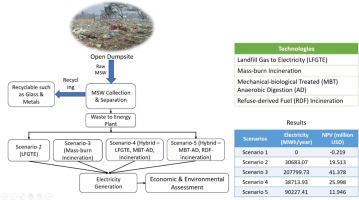Evaluating energy generation potential from municipal solid waste in an open dumping site of Khulna
IF 3.8
Q2 ENVIRONMENTAL SCIENCES
引用次数: 0
Abstract
The expanding global population, waste output, land scarcity, and environmental deterioration make waste-to-energy (WtE) technology a feasible option for managing MSW. This study explores the economic benefits of WtE in the Rajbandh open dumpsite in Khulna and the potential of generating energy from MSW. The electricity generation potential under alternative scenarios namely scenario 2 (landfill gas to electricity (LFGTE)), scenario 3 (mass-burn incineration), scenario 4 (hybrid LFGTE, mechanical–biological treated (MBT) anaerobic digestion (AD) and incineration), and scenario 5 (hybrid AD and refuse-derived fuel (RDF) incineration) is based on projected waste generation over the next 20 years, taking population growth into account. These four options are compared to Business as Usual (BAU). Scenario 3 has the highest electricity generation capacity at 207799.73 MWh/year, followed by hybrid RDF-incineration/MBT-AD (scenario 5), LFGTE, however, lowest generation at 30683.07 MWh/year. Net Present Value (NPV), Levelized Cost of Electricity (LCOE), and Payback Period define each scenario’s economic feasibility. Due to its greatest NPV of approximately 41.378 million USD, Scenario 3 is the most economically beneficial. Sensitivity analysis has been done selecting some sensitive parameters to evaluate the robustness of the output. Waste reduction model (WARM) estimates greenhouse gas (GHG) emissions and energy use for each scenario. However, scenario 3 has the lowest GHG emissions and energy use. In addition to reducing GHG emissions and energy usage, recycling waste increased NPV and economic benefits. This analysis reveals that scenario 3 is the best way to generate power, provide economic benefits, and reduce energy consumption for ecologically friendly waste management in Khulna City.

评估库尔纳露天垃圾场城市固体废物的能源生产潜力
随着全球人口的增长、废物产量的增加、土地的稀缺和环境的恶化,废物变能源(WtE)技术已成为管理城市固体废物的可行选择。本研究探讨了在库尔纳 Rajbandh 露天垃圾场进行 WtE 的经济效益,以及利用城市固体废物产生能源的潜力。根据对未来 20 年垃圾产生量的预测,并考虑到人口增长因素,对备选方案(方案 2(垃圾填埋气发电 (LFGTE))、方案 3(大规模焚烧)、方案 4(混合 LFGTE、机械生物处理 (MBT) 厌氧消化 (AD) 和焚烧)以及方案 5(混合厌氧消化和垃圾衍生燃料 (RDF) 焚烧)的发电潜力进行了分析。这四个方案与 "一切照旧"(BAU)方案进行了比较。方案 3 的发电量最高,为 207799.73 兆瓦时/年,其次是混合型 RDF-焚烧/MBT-AD(方案 5),然而,LFGTE 的发电量最低,为 30683.07 兆瓦时/年。净现值 (NPV)、平准化电力成本 (LCOE) 和投资回收期确定了每个方案的经济可行性。方案 3 的净现值最大,约为 4137.8 万美元,因此经济效益最高。敏感性分析选择了一些敏感参数,以评估输出的稳健性。减少废物模型(WARM)估算了每种方案的温室气体(GHG)排放量和能源使用量。然而,方案 3 的温室气体排放量和能源使用量最低。除了减少温室气体排放和能源消耗外,废物回收还增加了净现值和经济效益。该分析表明,方案 3 是库尔纳市进行生态友好型废物管理的最佳发电方式,既能提供经济效益,又能减少能源消耗。
本文章由计算机程序翻译,如有差异,请以英文原文为准。
求助全文
约1分钟内获得全文
求助全文
来源期刊

City and Environment Interactions
Social Sciences-Urban Studies
CiteScore
6.00
自引率
3.00%
发文量
15
审稿时长
27 days
 求助内容:
求助内容: 应助结果提醒方式:
应助结果提醒方式:


